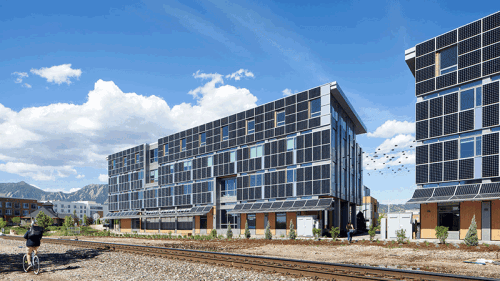Americans are voraciously consuming digital content. The Consumer Technology Association estimates that consumers will spend $151 billion on technology services (the category for video, gaming, audio, and apps) in 2023, marking five consecutive years of growth.
Entertainment companies are hurriedly working to meet this demand by ramping up television and film production. The increase in content creation has catalyzed a shortage of studio and sound stage space in Los Angeles, the global leader in the market, driving a record utilization rate of 94 percent, according to data from Film LA. For comparison, in 2017, the average utilization rate was 70 percent.
While television and film production companies are primarily driving the demand for studio space, the market for digital content runs deeper than Netflix, HBO, and Disney+. Social media is a mighty, although often overlooked, element of content consumption globally. The social media content market is projected to expand at an annual rate of 12 percent through 2030, driven by online retailers utilizing these platforms as marketing tools.
Brands are leveraging social media platforms to promote products, facilitate sales, increase conversion rates, and drive traffic to the main website—and they need to churn out a tremendous amount of daily content as part of the standard business model. To keep up with demand, brands are beginning to lease dedicated space for content creation.
Social Media Content Driving Retail Revenue
Visual social media platforms operate as advertising engines. Every month, 95 percent of working-age internet users visit a social media platform, according to data from Shopify, giving brands direct access to consumers. In fact, nine in every 10 shoppers buy from brands that they follow on social media, incentivizing retailers to develop a cohesive social media marketing strategy, which includes managing a branded account, leveraging partnerships with influencers, and placing paid advertisements.
Together, these strategies support strong sales and expand market reach. Research from Meta for Business found that retailers with both branded content and day-to-day campaigns increase content views by 87 percent, improve click-through rates by 40 percent, and increase the likelihood of conversions by 80 percent.
Pursuing a scaled social media strategy, however, requires producing a substantial amount of timely material. Shopify calls content creation one of the top challenges for marketers, highlighting the intensive process of production across multiple social media channels. The strategy not only requires a dedicated team but a dedicated studio space. Traditionally, the studio market for social media content has been fragmented, with largely mom-and-pop ownership or marketplaces like Peerspace, but institutional owners are beginning to see value in this demand segment.
“As a result of how we consume content and the demand for more content, and as the pressure to produce increases, we’re seeing the demand grow from needing space for one- to two-day shoots to a long-term need for space,” says Karen Yi, director of brand marketing at Atlas Capital Group, a commercial real estate owner that has seen an increase in demand for social media content production space at its retail properties. “For some brands, it has even become an office requirement. This need is becoming a trend we are seeing in the market.”
This movement is still in its infancy. Social media advertising accounts for a third of all internet ad revenue, but research from the Interactive Advertising Bureau expects social media advertising to grow nearly 6 percent this year. In addition, one-third of brands expect to increase social media marketing efforts, fueling more demand for the types of dedicated studio locations that Yi suggests. “With the growing use of social media among consumers, we only anticipate that more and more companies will enter the production space market to meet the demand for content and to reach their target audience,” she says. “Brands need to keep up with the demand to produce fresh content.”
Shopify’s 2023 report identified social media expansion as a key trend this year, saying, “Brands are leaning heavily on social media to engage, convert, and retain customers.” It has become an opportunity for brands to can a competitive advantage in a crowded online retail marketplace.
Moonlighting as Studio Space
As social media marketing continues to expand and drive business, retailers will need to secure a studio location, but there is a shortage of proper, quality production space in Los Angeles. Large entertainment companies are first in line for those spaces, locking many up with long-term leases and paying a premium. Costs for studios were up 15 percent last year, according to The Hollywood Reporter.
Online retailers and other brands with social media content needs are transforming retail spaces into makeshift production studios. According to Yi, companies are looking for spaces with high ceilings and natural light. ROW DTLA, a mixed-use office and retail property on 30 acres (12.1 ha) in Downtown Los Angeles owned by Atlas Capital Group, has several tenants utilizing space for social media content production, including Revolve, Shopify, and David Chang’s Majordomo Media, which has a multi-year partnership with LG to produce original content.
There is a deep well of opportunity here. A diverse mix of brands, both direct-to-consumer and omnichannel retailers, need to curate content as a tool to drive business revenue and expand market share. With an excess of retail and office space spurred by the pandemic, property owners are also open to alternative uses, like filming and studio locations. In December, the New York Times reported the Midtown Manhattan office buildings were partnering with a company called Backlot to monetize vacant floors and convert them into office spaces.
But, there is a delicate balance here. Retail property owners aren’t abandoning the brick-and-mortar storefronts, but rather social media studios illustrate the broadscale of new retail uses and user profiles. This is a way for landlords to support retail tenant both on and offline. As Yi explains, ROW has worked toward carefully curating this mix, to provide public-facing retailers and support alternative uses.
In 2023, one in every five retail sales will be made online. For online retailers, social media content is a brand’s opportunity to engage with customers, build loyalty, and ultimately drive revenue. As online retailers build digital empires, the social media content studio is becoming a standard requirement.





